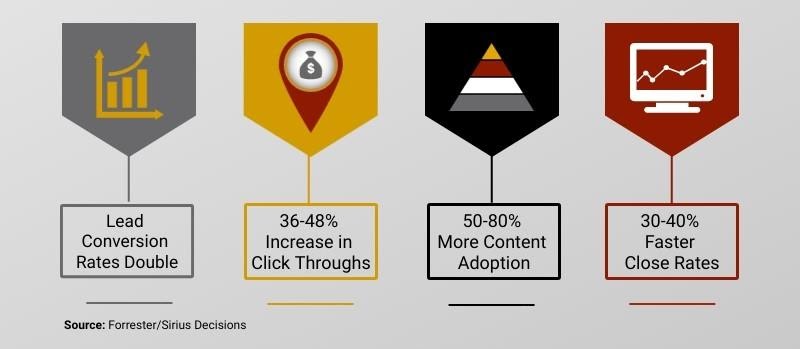One of the main characteristics of an actionable Buyer Persona is that it should reveal insights about the specific buying decision you want to influence. It’s NOT enough to describe an individual or role.
This is a critical distinction that’s at the heart of whether your investment in Buyer Personas will reap the marketing and sales results you seek. It’s also a distinction that isn’t fully understood or appreciated by most of the marketing and sales community.
Buyer Profile vs Buyer Persona
Let’s quickly define what we mean by a Buyer Profile and a Buyer Persona so we can talk about why these distinctions matter:
What is a Buyer Profile?
A “Buyer Profile” describes the characteristics of a particular individual involved in the buying decision – their role, industry, enterprise size, geography, priorities, etc. They reveal little or no insight about the specific buying decision you are trying to influence.
What is a Buyer Persona?
A “Buyer Persona” includes a Buyer Profile PLUS detailed insights about the buying decision including what we call the 5 Rings of Buying Insight:
- Pain points that trigger a buyer to look for a solution that you offer (Priority Initiatives)
- Outcomes a buyer expects from their investment in that solution (Success Factors)
- Concerns a buyer has about making the investment, or making it with you (Perceived Barriers)
- Questions buyers have about your solution and capabilities (Decision Criteria)
- Steps taken, resources trusted, and people involved in the buying decision (Buyers Journey)
Thorough Breakdown of What a Buyer Persona Is Here
While marketing and sales professionals frequently talk about “buyer personas”, look closely and you will see that they are actually describing “buyer profiles”.
To summarize:
- Buyer Profile = characteristics of an individual or role
- Buyer Persona = Buyer Profile + detailed insights about the buying decision
Why Are Insights About the Buying Decision So Important?
Definitions aside, why should you ensure that your Buyer Personas include insights about your customer’s buying decision? There are two key reasons:
First, Buyer Personas are best suited for higher stakes buying decisions.
Typically those where multiple solution options are considered, the decision is made infrequently, and there are significant consequences in making the right or wrong decision. For these types of decisions, you are competing on trust – buyers can’t afford to make mistakes and need to believe that you are qualified to deliver everything they need. These higher stakes decisions are not about price, the competitors that win the “trust battle” consistently win the business.
Reverse engineer that thinking and it’s easy to see that marketing and sales teams need to:
- Empathize with the factors that first trigger your buyer’s decision to consider a solution like yours. Demonstrate that you understand why buyers need to make a change now, what outcomes they expect from their investment, and what fears/concerns they have about making the purchase, or making it with you. Mapping features to benefits is a provider-first view that buyers aren’t interested in. Demonstrate that you understand the BUYER’S situation, needs, and concerns to begin to build real trust.
- Anticipate, educate, and address all the questions that arise during their decision process. Once buyers start the evaluation process, they reward organizations that best anticipate their questions and concerns. You want to be the sales and marketing organization that is fully qualified to educate buyers about relevant features and capabilities, demonstrating your ability to deliver exactly what they need. Everything else is white noise.
- Deliver the information and buying experience buyers need to make a confident decision. It’s useful to remember that this is the buyer’s experience, not yours. Providing prospective customers with the information they need, when and where they need it, positions you as the market’s leading experts.
Buyer Personas that include insights about the buying decision tell you exactly how you can develop game-changing marketing strategies and content. Buyer Profiles leave huge gaps that you must fill with guesswork.
Second, by focusing on the buying decision you will reduce the number of personas you need and improve their impact.
Over the last decade, we’ve interviewed thousands of buyers and developed many hundreds of personas. Psychographics and demographic characteristics of an individual or organization almost never differentiate B2B buyer personas.
- Psychographics – a statistical analysis might tell you that most CFOs are risk-averse, satisfying your desire to put a label on this persona. But wouldn’t it be more helpful to understand how CFOs make decisions to invest in a solution like yours?
- Geography – our increasingly global economy has homogenized the business buyer’s needs. It is increasingly rare to find buyers whose approach to a particular buying decision varies by location.
- Industry – other than preferring a provider that focuses on the buyer’s industry, there are rarely differences in the mindset, needs, and behaviors of buyers across sectors.
- Company Size – potentially the exception, a company with 10,000 employees often has different buying expectations than one with 1,000 or 100. If you are marketing to companies across a wide range of company sizes, you should expect that you will need multiple personas. Company size affects the complexity of the buyer’s journey, number of decision makers, and questions they ask.
A Buyer Profile that describes the characteristics of individuals in the buying decision makes a great “cover sheet” for your Buyer Persona (it’s the first page in all the persona work we do).
When you focus your Buyer Personas on insights about the buying decision, your marketing and messaging will tightly align to everything that matters most to prospective customers. You will earn their trust, and their business.





